Most parents are usually prepared for the appearance of a long -awaited child ...
|
|
A couple of years ago it was impossible to imagine a laminate that was laid in a bathroom or in ... |
When purchasing plastic windows, first of all, you need to pay attention to their ... |
DIY sewage system in a private house
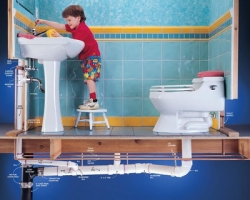
Modern suburban houses are no longer inferior in the degree of comfort and convenience of the apartments of megacities, and sometimes even surpass them. Until recently, life on its own plot of land was not popular because of the need to bring water and take care of removing human life. What can I say, even frequent exits to the street for natural needs delivered certain inconvenience, especially in winter. Now all these problems are successfully solved by equipping their housing by private sewage. At the same time, modern cleaning systems cope so well with their purpose that the drains, dropped back into the soil, are cleaned in them by 95-98% and do not pose any danger to the environment. But about this and how to correctly install a sewage system in a private house with your own hand, we will tell you a little below
Table of contents
- Types of sewage of a private house
- Design stage
- Some tips for the installation of sewer systems
- Installation of storm sewers
- Installation of household sewers
Types of sewage of a private house
First, let's talk about the types of sewage systems that need to equip every country house. As a rule, the owner will definitely have to take care of the storm and household systems.
Livne sewage system is a system for draining excess water from the roofs of buildings, paths, sites. It serves to prevent the flooding of basements, the formation of a puddle on the site and glaciation of the surface of the earth in winter.

The household system is designed to collect and remove human life. It, in turn, is divided into internal and outer:
- the outer sewage system is responsible for the removal of effluents to the cleaning systems, which include elk (local treatment facilities), septic tanks and drain pits. It consists of treatment, pumps, wells, pipelines, releases and filters.
- interior sewage system is a wastewater collection system inside the home. Its main elements are various plumbing equipment and pipelines.
Depending on the method of movement of effluents, the outer sewer can be divided into gravity, in which the waste is released by the difference in the heights of the pipeline, and the pressure that differs in the presence of pumps forcibly moving wastewater to the cleaning system.
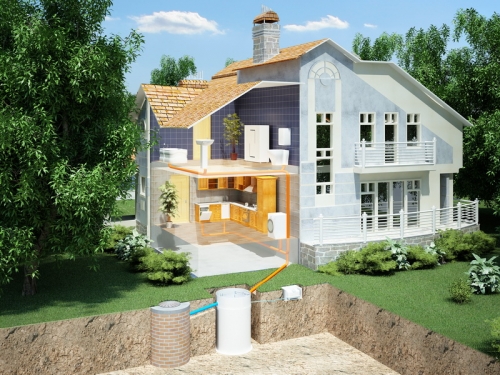
Both storm and household sewers can be combined into one network, in this case the system is called community. If they have different networks, then the system is considered separate.
Now let's talk more about the types of household sewers:
- An ordinary drain pit. This type is familiar to people since ancient times and is still sometimes used. What are its advantages? This is cheapness and ease of installation. But these advantages are completely crossed out by an unpleasant odor, which spreads over a fairly long distance around the pit, and even about the aroma accompanying the cleaning of the pit from the drains, it remains only to remain silent. If you place a special reservoir in the pit for wastewater accumulation, then it will be possible to get rid of the unpleasant odor, but the costs of emptying it (it is worth noting, quite frequent) and in this case cannot be avoided.
- Filter wells. This system is constructed from several reinforced concrete rings laid on each other and forming a well. The bottom remains leaky and simply falls asleep with a meter layer of crushed stone or gravel. The same material is filled with a gap formed between concrete rings and soil. Such systems are functioning correctly only on sandy soils that pass the wastewater through themselves. The filter wells are not filled longer, and this increases their efficiency in comparison with cesspools, but still they are inferior to septic tanks and compulsory cleaning systems.
- The most common sewer systems in modern private houses are septic tanks. In them, cleaning occurs in several stages. Septic tanks are considered more environmentally friendly systems than all of the above, and they are required to clean them only once a year. The largest minus of such a sewage system is a large area.
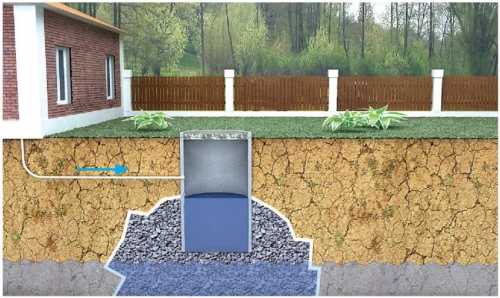
The sewage sewage for each individual private house is carried out only after analyzing the conditions of the terrain and the selection of technical and economic indicators, taking into account SNiP. The most important indicators on which you need to focus on are climatic conditions, soil type on the site, the level of underground water and freezing of the soil, planned to discharge effluents and the area of \u200b\u200bthe site, which can be distinguished for treatment systems.
Design stage
Before starting work, it is necessary to carefully plan the entire sewage system. It is better if it is done at the stage of designing the house. Such a measure will allow you to more compactly place the premises in the house so that plumbing equipment is placed in one place and connected to one collector. If the autonomous sewage system is carried out in an already built or very large country house, and the convenient location of the plumbing is already impossible, you should try to draw up the sewage circuit in such a way as to reduce the amount of necessary drainage pits to a minimum.
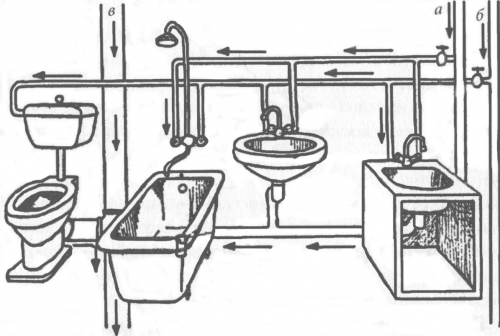
When drawing up a plan to a person who has never dealt with sewer systems, it is very difficult to take into account all the nuances of the structure and site, so it is better to entrust this work to real professionals, but you can already mount the sewer according to ready -made schemes with your own hands.
Some tips for the installation of sewer systems
- According to SNiP, the distance from the sewer pit to the structure should be more than 5 m.
- It is better to arrange a pit so that it is easy to drive up to it with a car that pumps out its contents.
- Pipes for drainage of life products are best chosen with a large diameter and arrange them as directly as possible. The fewer turns and bends, the less often the pipe will be clogged. In addition, every 2-4 meters of the outer pipe, it is necessary to install a tee with output, the so-called revision that allows you to quickly clean the blockage using a cable. To prevent freezing for the winter, the audit should be covered with insulation.
- The dimensions of the pit for a septic tank should be at least 20-25 cm larger than the tank itself, and its bottom is located below the level of freezing of the soil, and no less than 70-80 cm.
Installation of storm sewers
It is better to arrange the drain of storm water separately from the flow of households, because otherwise you will have to install a septic tank of a much larger size. And unlike life waste, almost always containing any chemical impurities, such as washing powder or other detergents, rain water can be used for watering or for any other technical needs.
Installation of storm sewers is not particularly difficult. The main thing here is to properly organize the slope of the drainage pipes. It should be 10-20 mm/m. It is better for this purpose to use PVC pipes with a diameter of at least 110 mm. As a rule, they are remarkably coping with the volume of storm waters of our region. Next, along pre -marked lines, you need to dig trenches and carefully compact them. A sand pillow with a thickness of 10 cm will help to avoid deformation and damage to the pipes when filling them.
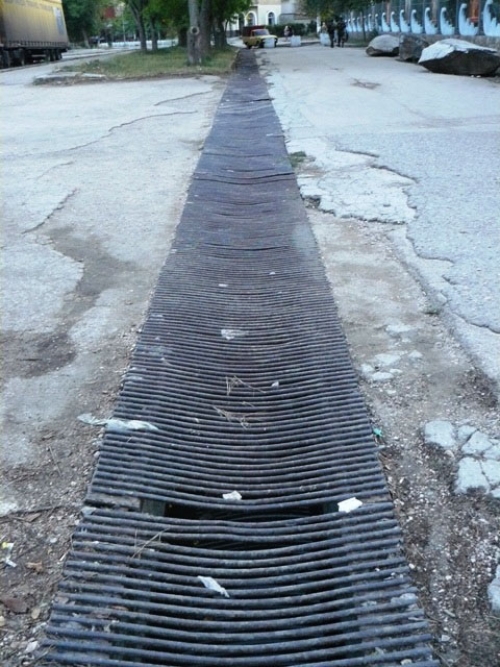
After that, it is necessary to install rain recreants in the collection of storm water from all over the site. It is from here that the drains are dumped into the collector, and here they are cleaned if necessary. Such a water collector must be equipped with a special funnel, exactly the same as in the upper part of the vertical drain pipe, otherwise it is unlikely that storm drains will fall into it. The funnel, in turn, is closed with a filter-set that prevents the entry into the drain of garbage, fallen leaves and other contaminants.
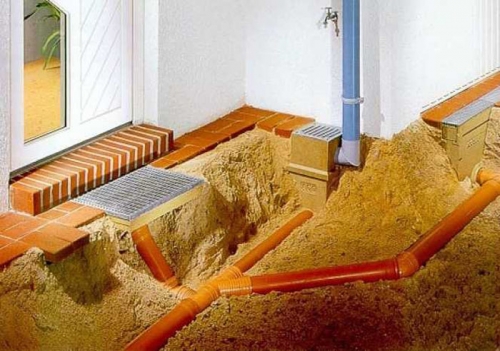
Now all the elements are connected, and the system can be launched. True, it is still better to carry out a trial launch. To do this, a certain amount of water is poured into one of the funnels. By its exit, one can judge the presence of leaks in the system, and by the speed of passage about the correct installation. Most often, rain drains are released into ditches or natural reservoirs.
Installation of household sewers
We begin the installation of the sewer with the digging of the pit. We have already talked about its size above, but the depth should be such that the neck of the septic tank installed in it is located just above the level of the surface of the earth.
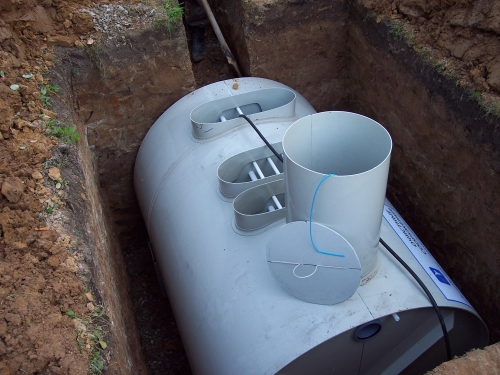
The bottom of the pit is filled with sand, and the space formed by the walls of the tank and the pit, a mixture of sand and soil. At this stage, you can easily damage the septic tank, so before filling it must be filled with water.
Next, go to connecting plumbing. The toilet is necessarily connected to the system using a pipe with a diameter of 100 mm, and 50 mm will be enough for a sink and bath, while to exclude unpleasant odors to the room, this equipment at the output is equipped with a knee, which acts as a water plant. From the house, the pipes for the sewage system are excreted through a hole with dimensions of at least 30x30 cm so that when the structure is drawn, they are not accidentally damaged.
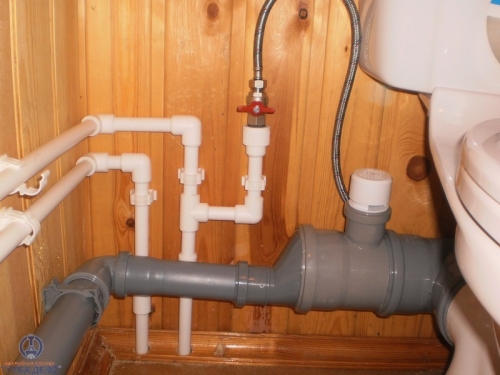
For internal sewer systems, plastic pipes and fittings are great, but the outer sewer is best carried out using more durable asbestos or cast -iron pipes. Plastic is allowed, but only if the freezing depth is not large, and there is no need to instill them deeply.
What should be the angle of tilt of the pipes when laying the sewage system? It depends on their diameter. If it is 100 mm, then 20 mm/m is enough for proper functioning, and if the pipes are narrower (50 mm), then the slope should be increased by 10 mm. But you should not be zealous with this, otherwise a heavy noise will be heard with the drain.
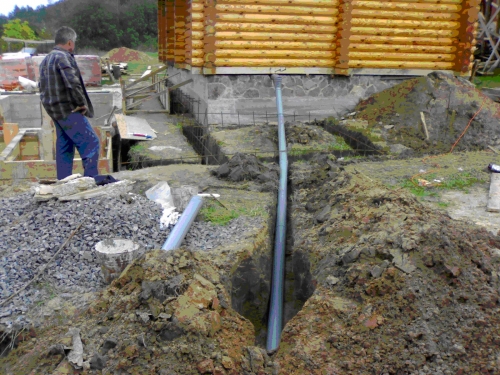
You can correctly arrange the sewage system yourself only in a small house. If you are a happy owner of a cottage with a sauna, a bath, several bathrooms and showers and a large number of people living in it, then you should not take risks. Contact professionals, and you will be able to avoid many troubles when operating the finished system.
